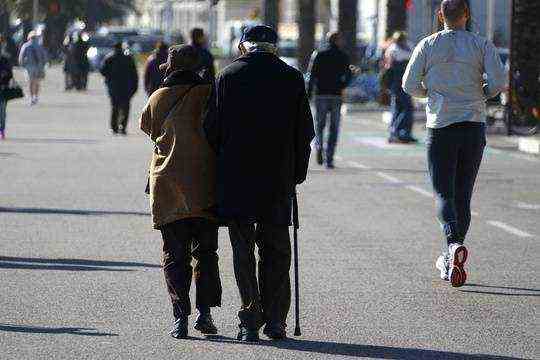As of 2019, significant disparities in life expectancy have been observed. – VALERY HACHE / AFP
- According to a study published in March, in 2019, Ile-de-France is the region where we live the oldest but significant disparities are noted.
- With the pandemic, life expectancy could decline more significantly in the region due to the power of the three epidemic waves.
The figures date from before the pandemic. At the time, finally, when we looked at them very little. In 2019, life expectancy increased in Ile-de-France, 81.4 years for men and 86.1 years for women, according to a
study published at the end of March by the Regional Health Observatory. If at first glance these data may seem obsolete in view of the health crisis, they nevertheless greatly shed light on the present situation. Because long before the Covid-19, territorial inequalities in health are glaring. We live two years less in Seine-Saint-Denis than in Paris. Interview with Valérie Féron, statistician, author of this study.
In your study, you note that in 2019, Ile-de-France is the region where we live the oldest but that it presents significant disparities …
The link between life expectancy and socio-demographic profile is very important. The more you belong to a higher socio-professional category, the more likely you are to live to be old. An INSEE study pointed out, for example, that executives live on average six years longer than manual workers. So if we look at the national level, Ile-de-France is one of the regions where we find the most executives, graduates, wealthy people … But we note significant disparities, social, economic, at the regional level which have direct consequences on life expectancy. In Stains, in Seine-Saint-Denis, women live seven years less than in the 16th district, in Villeneuve-Saint-Georges (Essonne), men live eight years less than in this same arrondissement. Generally speaking, there is more than two years less life expectancy in Seine-Saint-Denis than in Paris.
How to explain such disparities even though access to healthcare is free in France?
To be treated, you have to have the time to do it or even to think about it. We know that health is not necessarily everyone’s priority: people who face major social or economic problems will not necessarily have regular monitoring. In addition, the offer of care is not the same throughout the territory: Seine-Saint-Denis is a medical desert, it is more difficult to get an appointment with a general practitioner than in neighboring departments.
During the health crisis, Seine-Saint-Denis, the poorest department in France, recorded in 2020 the highest excess mortality in France. Was this mortality gap predictable?
In addition to the disparities I mentioned, several elements specific to this health crisis have been added. Many essential workers, who could not telework and were therefore particularly at risk, are from Seine-Saint-Denis or Val d’Oise, which was also very affected. Overcrowded homes also promote the spread of the virus.
Do we have any idea of the consequences of the health crisis on life expectancy in the region?
According to a recently published INSEE study, it is estimated that in 2020, life expectancy fell in France by six months for women and seven for men. We do not yet have the regional figures but the decline could be even more marked in Ile-de-France since the region has suffered the full brunt of the three waves. This will probably be a one-off drop, as during the 2003 heatwave which caused significant excess mortality, but it will be marked.

